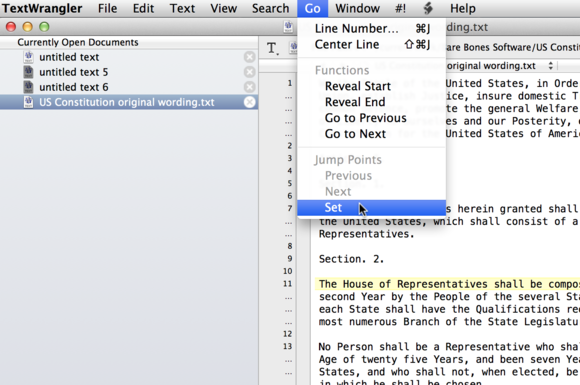

This entry was posted in Uncategorized on Octoby J.D. For Mac users using BBedit/TextWrangler for Ogre script editing, add the following files (plist xml format) to /Library/Application Support/TextWrangler/Language Modules/ (or the appropriate path for BBEdit) to get basic keyword and comment colouring and block recognition for. You can copy the entire folder to TextWrangler’s scripts folder, and it will create a new menu item named WordPress.
#Textwrangler script zip
Here’s a zip of my folder which includes filter and action look-up in addition to the function look-up. Just change the target URL and dialog text accordingly. You can easily customize this script to look up anything you want anywhere you want. Either way, the codex page for that function will open in your favorite browser. This will open a dialog prompt for you to type whatever function you want to look up, or if you have already selected the function’s name on the page, it will use that. Set function to text returned of (display dialog "WordPress Function:" default answer "") Set function to selection of window 1 as string Here’s what you can put in the file to look up a function on the WordPress codex: (To open the scripts folder, click on “Open Scripts Folder” under the scripts menu). Then you can access it from the scripts menu, which is the one with the little script icon. It’s easy to add that feature to TextWrangler, just by adding an AppleScript file to the scripts folder ( ~/Library/Application Support/TextWrangler/Scripts/).
#Textwrangler script code
And with WordPress, that might be a function, a filter, or an action. it works with files (reading from file instead of standard input) there is a non-optional argument command, as phptidy has lots of features it does not break lines after semicolons so I had to tweak the code a little. Sometimes you want to look up something in the WordPress documentation, straight from your code editor. It will take a few moments, and then create timing files for all of your subjects.I use TextWrangler as my code editor. Now navigate back to the directory containing all the subjects, remove the sub-100 directory and run the script. This is discussed in more detail in the book chapter in the link below. Then, you can use conditional statements in awk to print the onset times for specific experimental conditions, and redirect that output into a corresponding text file. You can redirect the output of this command into the input for the awk command by using a vertical pipe. In order to help create your own editor enhancements, you can use the functions in geneditorutils. For our fMRI analysis, we want the columns that specify the onset time and duration, as well as the number 1 as a placeholder in the last column. Notepad++ Sublime Text TextMate TextWrangler vi/vim. Here are the basics about how it works: If you go into a subjects’ func directory and type cat sub-08_task-flanker_run-1_events.tsv, it will return all of the text in that file. Awk is a text processing command that prints columns from a text file. The body of the for-loop contains something else that is new, a command called awk. This is a simple example, but you can see how you can add as many lines of code as you want. This will run all of the code in the script, just as if you had typed it out by hand. In a Terminal, navigate to the Desktop and then type bash printNums.sh to run it. sh extension signifying that the file is a shell script.


Now click on File -> Save As and call it printNums.sh, with the. Some coders prefer to put a space between each major section of code this is a stylistic choice that is up to you. For example, before the loop we could write a comment about how the following code will print the numbers 1 through 3. It is also helpful to include comments with the pound sign: Anything written after the pound sign will not be interpreted by the shell, but is useful for the reader to know what the command is doing. This allows the eye to quickly see the structure of the code and guess where certain commands are located. It is good coding practice to indent the body of a for-loop or conditional statement, usually with a tab or a few spaces.


 0 kommentar(er)
0 kommentar(er)
